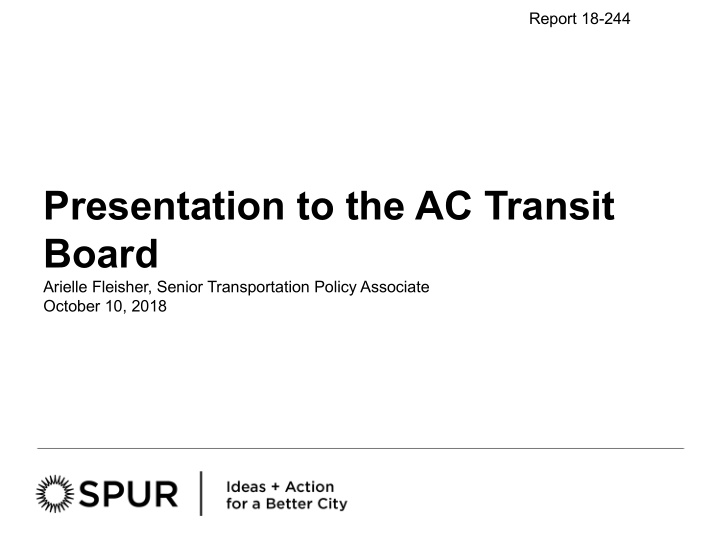



Report 18-244 Presentation to the AC Transit Board Arielle Fleisher, Senior Transportation Policy Associate October 10, 2018
Outline 1. How public transit fares work in the Bay Area today 2. Why simplify and integrate fares? 3. What can we learn from other regions? 4. Where can we go from here?
What is SPUR? SPUR’s mission is to promote good planning and good government through research, education and advocacy.
1. How public transit fares work in the Bay Area today 4
What is Fare Policy? The rules defining how much people pay to use public transit. 1. Fare structure – How will the price of a ride be set? 2. Price – What will a full-fare single ride cost? 3. Payment options – How will riders pay: single-ride tickets or daily; will be daily, weekly or monthly capping? 4. Discount categories – Which riders will qualify for a discounted fare, and how much will those discounts be?
How fares are set: Key roles and responsibilities Transit Agency Boards: Set fare policy. Each transit agency sets their own fare rules and prices. MTC: Manages and oversees the Clipper Fare Payment System; does not set fare policy Clipper Executive Board: Establish goals, a budget and work plan, and provide policy, oversight, direction, and authorization of significant business matters for the Clipper fare payment system.
Our Fare Policy is Disjointed
Multi-operator (integrated) fare policy Transit operators jointly organizing fare policies so that transferring between operators becomes more affordable or simpler in some way
2. Why might we simplify and integrate fares? 9
1. Riders want integrated fares
2. Disparate fares make riding transit confusing 28 In 2017, an average of 28 of AC Transit Clipper rides were financed with the SamTrans to AC Transit transfer
It is hard to understand the price of a ride SamTrans AC Transit
2. Our fare policies penalizes people who take multi-operator trips Use of AC Transit and Other Operators, 2017
3. Public transportation may be left out of the new mobility marketplace
4. Our fare policies do not support integrated planning and station design
5. Disparate fares limit the usability and appeal of a fare payment system Riders struggle to understand what Clipper supports and offers: • Does Clipper calculate transfers and discounts? • Does Clipper work across systems? • Does Clipper support cash in addition to passes?
Potential Outcomes From Changes to Fare Policy Improve customer experience Increase trust and and customer satisfaction Improve reliability Save money Grow region-wide transit ridership Optimize use of the Bay Area’s complete transit network Increase transit competitiveness 17
3. Examples from Other Regions and Lessons Learned 18
Lesson 1: Regional Fare Integration is Possible • Pay as you go daily and Hop Fastpass: Portland monthly pass • The pass works across three operators • Once a rider spends the value of a daily or a monthly pass, he or she won’t have to pay any more that day or month; riders automatically receive Seattle’s Puget Pass savings once they reach the cap 19
Puget Pass: Seattle • Monthly, multi-agency transit pass • For the price of 36 one-way trips, riders get unlimited transit at the selected trip value or less • Larger operators established a temporary subsidy for smaller operators to make the transition to the regional pass financially feasible Seattle’s Puget Pass 20
Fare Integration: Greater Toronto Hamilton Area • 11 different transit operators each set its own fare rules and prices . • In 2014, initiated a Business Case for Fare Integration to identify a common fare structure for the region. • Adopted a step by step approach beginning with discounts on double fares . Seattle’s Puget Pass 21
Lesson 2: Reducing Barriers to Transferring Promotes “Complete Journeys” Seattle’s Puget Pass 22
Lesson 3: Fare Simplification can Boost Transit Ridership • Transport for London reduced the fares zones for buses from 6 to 1 and found that new journeys appeared to be made merely because the new fare structure was easier to understand. • In Barcelona, the sales of Zone Map, Barcelona Metropolitan Region integrated tickets increased by 11.2% in the first full year after integrating fares.
Lesson 4: Fare Policy Can be a Tool for Transit Affordability • Many agencies use “fare capping” which allows riders to “earn” a day or monthly pass. • Fare capping gives riders the access to the savings of a daily, weekly or monthly pass and the security of knowing they will never pay more than a certain amount in a day or month.
4. Next Steps: What can we do about it? 25
Clipper 2.0 Provides the Opportunity to Simplify and Coordinate Fares
SPUR’s Solution for Clipper 2.0: Simplify + Coordinate 1. Simplify fares before Clipper 2.0 launches. Opportunities for simplification • Transfer policies • Fare products • Fare categories and their discounts • Minimum balance requirements 2. Coordinate transit operator fares Opportunities for coordination • Common fare structure for the region • Regional accumulator (local bus or inner-core/outer core) • Multi-agency pass
SPUR’s Vision for Integrated Fare Policy • Fares are easy for riders to understand, logical and coordinated. • Fares reflect the quality and value of the service provided, independent of location or any municipal boundaries. • Riders experience a common fare structure throughout the region, a standardized user experience and products based on trips taken— not by agencies used. 28
Considerations • Even small changes can have many direct and indirect impacts • A well-integrated fare system typically evolves over time • No single municipality or transit agency can solve this problem by itself; requires a collaborative and inclusive decision making process • There are many considerations: Governance and fare setting responsibility, role of municipalities, stakeholder concerns
Thank you! Arielle Fleisher afleisher@spur.org
Recommend
More recommend